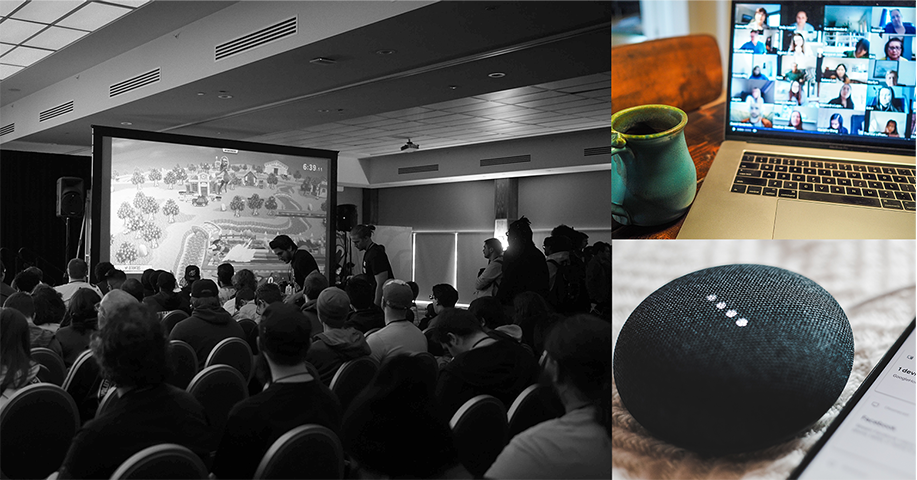
Macrotrends give us insight into the future. At the same time, Covid has thrown a macromonkeywrench into the macromachinery of what’s ahead. The language services industry is no exception. A survey by CSA Research showed 55% of LSPs (Language Service Providers) reporting an overall decrease in business.
Some sectors are being impacted negatively while others have revved up, according to the same survey by CSA Research, with the vertical markets Travel & Leisure, Events, and Airlines being the most hard-hit, while demand grew for Healthcare, Life Sciences, Medical and Pharmaceuticals. The contradictory forces of people traveling less but needing to know more are redefining what’s “business as usual” for many of us in the localization industry.
Contents
Events are moving online out of necessity and foresight
In 2020, Facebook moved their annual conference online, Microsoft brought their MVP Award Program online, Adobe took their summit online, nVIDIA moved their GTS conference online, Atlassian moved their summit from Las Vegas to online, CEATEC moved their annual expo from Tokyo to online, and the list goes on and on. These moves may have been drastic, but not surprising, as they were just acting responsibly during a pandemic.
What’s important here is that the pandemic took an existing trend and kicked it into overdrive, so companies were able to discover the pros and cons of the online event as opposed to in-person in ways they may not have realized before. The pros would include operational savings on venue fees, travel and accommodations, while the downside might include cumbersome interactivity, but practice makes perfect.
Translation workflows were impacted very little because they were already heavily internet-based, but interpretation services took a major hit. As people’s travel was limited and in-person events were put on hold, interpreters who worked face-to-face found their gigs canceled. But in those cases where interpretation could be provided online, there was hope.
The United Nations, where multilingualism is beyond important, interpreters needed to rapidly set up equipment to work from home and alone (instead of as a team in a booth). This was challenging, but as a result UN interpreters “return with a new set of skills – remote interpreting – that could be useful for business continuity purposes in the event of future unforeseen circumstances.”
Automation is accelerating to meet the need for speed
Whether it’s in services, manufacturing or finance, the drive toward more automation is a clear macrotrend that will continue moving forward. The need to increase output (both volume and speed) while lowering costs is a common theme worldwide. In the language services industry that would mean increased reliance on machine translation, which is increasingly being driven by AI (Artificial Intelligence).
In fields where there is sufficient corpora to “learn” from, AI-based domain adaptive NMT (Neural Machine Translation) will close the gap between machine and human translation. But, whereas NMT is a good investment for content that explains, there will still be plenty of opportunities for human linguists to shine in content that expresses and inspires.
As AI grows more sophisticated and better able to understand nuance and intent, there are still cultural and contextual aspects to language where the machine falls short of mankind. But the gap is closing. Ironically, post-editors working in MTPE (Machine Translation Post-Editing) workflows will find it increasingly challenging to find and correct the accuracy issues that may be hidden behind the almost “deceptive” fluency of machine-translated texts.
Voice technology is telling us what’s ahead
2020 was a year that found a lot of us stuck at home, talking to ourselves or to our personal digital assistants. Whether you “Hey Siri,” “OK Google,” or just blurt out “Alexa!” it’s likely that a PDA (Personal Digital Assistant) or smart speaker has become part of your daily lives. Coupled with a pandemic that has more people searching for and buying things online, this trend is not just strong but also very future-intensive.
In voice search going forward, we expect (or hope) to see strong collaboration between AI and humans to enable AI to better figure out user intent, as the customer base becomes ever more global and multilingual, including dialectical differences that could confuse AI that’s not up to the task. Is “Barbie” referring to a doll or a barbeque? Is “boot” something you wear or part of a car? Did he just say “mate” or “might,” “about” or “a boat”? Figuring those out would require knowledge of context, dialect and accent.
The rise of video marketing necessitates localized video content, much of which is accommodated through multilingual onscreen subtitles. But increasingly, companies are opting for multilingual voice-overs that have been made more accessible through TTS (Text-To-Speech) technology. In fact, the global market for voice technology is expected to grow by over 600% between now and 2027 as people increasingly choose to listen to content rather than read it.
Another important aspect of TTS is the way it is fueling the growth of the audiobook market. Eagerly embraced by millennials, audiobooks provide users with an immersive experience and enable people to “read with their ears” even while their eyes are occupied with other things. And as the market becomes more global, the need for multilingual TTS also increases.
Multilingual support is a necessity for growth
Due to the pandemic, less people are in town shopping, but that doesn’t mean they’re shopping less. The shopping arena has shifted from brick-and-mortar shops to online markets in a way that may be at least partially permanent. And an online customer is more likely to be living halfway around the globe than around the corner. This sort of global and multilingual customer base spawns the need for multilingual customer support, whether it’s at the retail level through a multilingual online presence, or multilingual customer support to handle any customer grievances or other issues. Keeping the customer satisfied is mission-critical in any language.
Transcreation is a must to really connect to customers
Whereas translation (changing sentences from one language to another) and localization (adapting collateral to a specific locale) play essential roles in expanding your brand or service to a broader clientele, it is transcreation that lets you connect with potential customers on a deeper level. Transcreation is best described by Arle Lommel, Senior Analyst for Common Sense Advisory, as “the creation of content in the target language that is inspired by the source, but highly adapted for the language and culture where it will be used.” From the transcreator’s standpoint, the so-called source text is used only as reference material and not as the source in the usual sense.
Again, transcreation is neither essential nor necessary in every aspect of your site or other materials. Where you need to explain, translation is all you need. But where you need to express things in a way that evokes an emotional response, transcreation would be your solution.
Douglass McGowan






